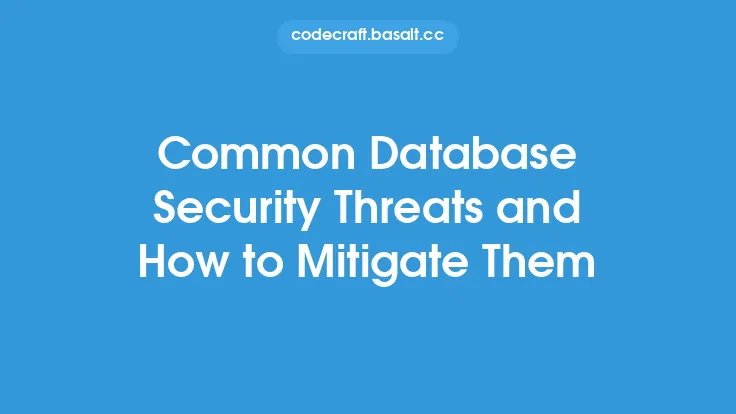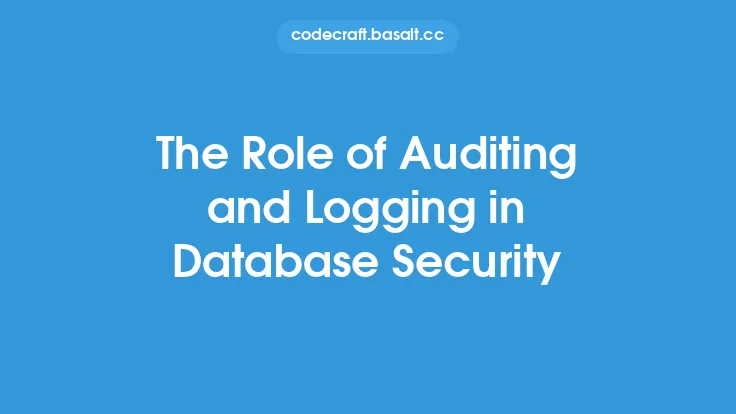Database backup and recovery are critical components of a comprehensive database security strategy. While backups are essential for ensuring data availability and integrity, they also introduce security risks if not properly managed. In this article, we will delve into the security considerations surrounding database backup and recovery, highlighting the importance of protecting sensitive data, preventing unauthorized access, and ensuring the confidentiality, integrity, and availability of database backups.
Introduction to Database Backup Security
Database backups contain sensitive data, including personal identifiable information, financial data, and other confidential information. If backups fall into the wrong hands, they can be used for malicious purposes, such as identity theft, financial fraud, or corporate espionage. Therefore, it is essential to implement robust security measures to protect database backups from unauthorized access, theft, or tampering. This includes using encryption, secure storage, and access controls to ensure that only authorized personnel can access and manage backups.
Threats to Database Backup Security
Several threats can compromise the security of database backups, including:
- Unauthorized access: Insiders or external attackers may attempt to access backups to steal sensitive data or disrupt business operations.
- Data breaches: Backups can be stolen or compromised during transmission or storage, leading to data breaches and unauthorized disclosure of sensitive information.
- Data corruption: Backups can become corrupted due to hardware or software failures, human error, or malicious activities, rendering them unusable for recovery purposes.
- Backup tape or media loss: Physical backup media, such as tapes or disks, can be lost, stolen, or damaged, resulting in data loss or unauthorized access.
Best Practices for Secure Database Backup
To mitigate these threats, organizations should implement the following best practices for secure database backup:
- Encrypt backups: Use robust encryption algorithms, such as AES, to protect backups from unauthorized access.
- Use secure storage: Store backups in a secure location, such as a encrypted file system or a secure cloud storage service.
- Implement access controls: Restrict access to backups to authorized personnel using secure authentication and authorization mechanisms.
- Use secure transmission protocols: Use secure transmission protocols, such as SSL/TLS, to protect backups during transmission.
- Monitor and audit backup activities: Regularly monitor and audit backup activities to detect and respond to potential security incidents.
Database Recovery Security Considerations
Database recovery is the process of restoring a database from a backup in the event of a failure or data loss. While recovery is essential for ensuring data availability, it also introduces security risks if not properly managed. Some of the key security considerations for database recovery include:
- Authentication and authorization: Ensure that only authorized personnel can initiate and manage the recovery process.
- Data validation: Validate the integrity and authenticity of the backup data to prevent the introduction of malicious or corrupted data.
- Configuration and parameter settings: Ensure that the recovered database is properly configured and parameter settings are correctly applied to prevent security vulnerabilities.
- Patch management: Ensure that the recovered database is up-to-date with the latest security patches and updates to prevent exploitation of known vulnerabilities.
Secure Database Recovery Techniques
To ensure secure database recovery, organizations should implement the following techniques:
- Use secure recovery tools: Use secure recovery tools, such as encrypted recovery media, to protect the recovery process from unauthorized access.
- Implement role-based access control: Restrict access to the recovery process to authorized personnel using role-based access control mechanisms.
- Use secure communication protocols: Use secure communication protocols, such as SSL/TLS, to protect the recovery process from eavesdropping and tampering.
- Monitor and audit recovery activities: Regularly monitor and audit recovery activities to detect and respond to potential security incidents.
Cloud-Based Database Backup and Recovery Security
Cloud-based database backup and recovery introduce additional security considerations, including:
- Data sovereignty: Ensure that cloud-based backups are stored in a secure and compliant manner, adhering to relevant data sovereignty regulations.
- Cloud storage security: Ensure that cloud storage services provide robust security features, such as encryption, access controls, and monitoring, to protect backups from unauthorized access.
- Cloud-based recovery security: Ensure that cloud-based recovery processes are secure, using techniques such as secure authentication, authorization, and communication protocols.
Conclusion
Database backup and recovery security are critical components of a comprehensive database security strategy. By understanding the threats to database backup security, implementing best practices for secure database backup, and ensuring secure database recovery, organizations can protect sensitive data, prevent unauthorized access, and ensure the confidentiality, integrity, and availability of database backups. Additionally, organizations should consider the security implications of cloud-based database backup and recovery, ensuring that cloud storage and recovery services provide robust security features to protect sensitive data. By prioritizing database backup and recovery security, organizations can minimize the risk of data breaches, ensure business continuity, and maintain the trust of their customers and stakeholders.





